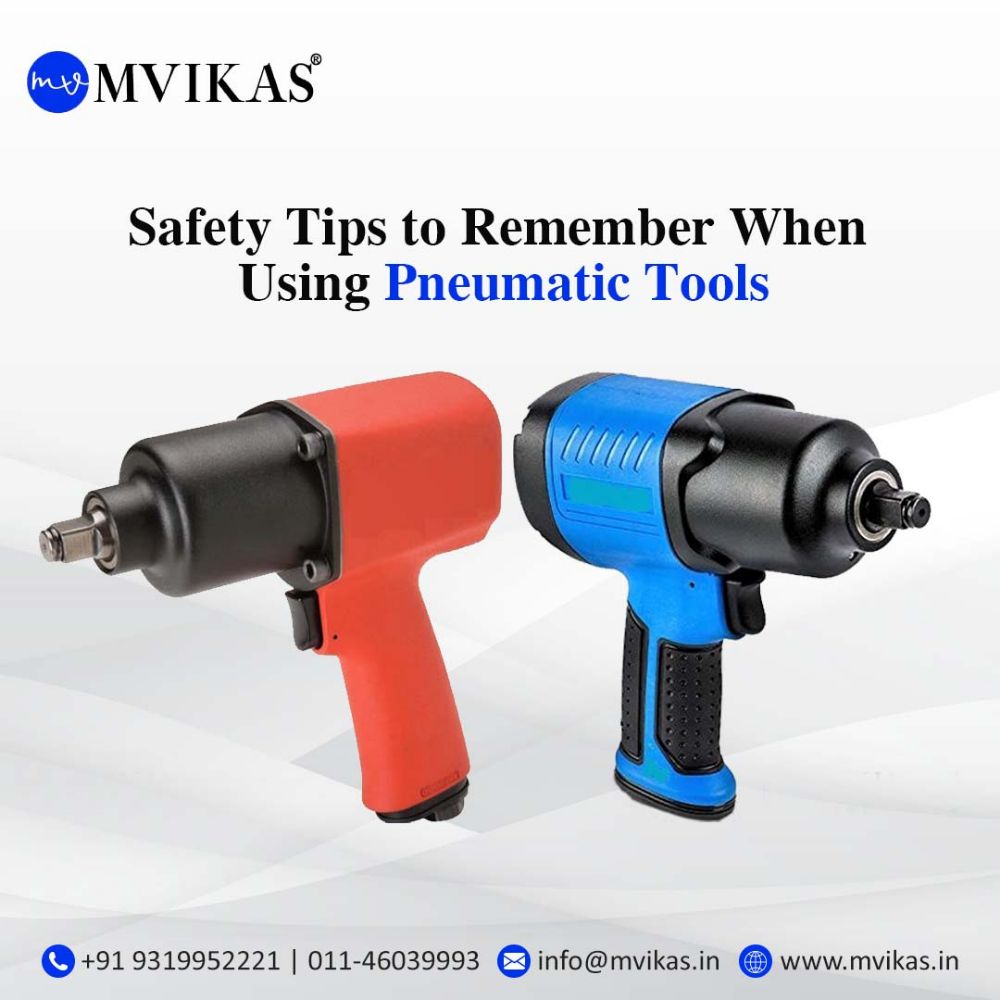Reachable at 9560662883  011-46039993 (Ext. 21 to 32) (10am - 06pm)
011-46039993 (Ext. 21 to 32) (10am - 06pm)
Safety Tips to Remember When Using Pneumatic Tools

A pneumatic tool works with compressed air rather than electricity. All pneumatic tools require an air compressor to generate a pressurized burst of air to function. Because pneumatic tools may perform a broad range of jobs, it's critical to understand how much air a specific tool will use and how much pressure is required to execute its function. A tool's volume and pressure requirements will determine the strength of the air compressor needed to power your device.
Pneumatic tools are not only easier to manoeuvre, but they are also less expensive than electric equipment. Pneumatic tools have higher initial costs but reduced long-term costs. The devices are less costly than their electric equivalents, and they last longer—but they also require air compressors, which dramatically increase the price. They are solid and efficient, making them an excellent choice for almost any work, but they are not the same as your electric equipment.
When using such tools, remember to add a few drops of pneumatic tool oil to the tool at the end of the day to preserve its inside metal components from any leftover moisture accumulated throughout the day. It is vital not to over-lubricate your pneumatic tools since this might cause them to fail. Pneumatic tools are designed for heavy use and are essential in industrial settings, yet we disregard their maintenance requirements.
However, proper management of pneumatic equipment is critical to ensuring productivity, meeting customer objectives, and operator safety. For optimal functioning, lubricate pneumatic tools regularly. Consider not using oil in your vehicle's engine. It wouldn't be long until that engine seized.
Here, are a few safety tips that you must remember when using Pneumatic Tools.
- Don’t use damaged tools
One of the first rules to remember is never to utilise a damaged pneumatic instrument in an industrial setting. It might be hazardous. At all costs, avoid doing that. Remove such tools as soon as possible. Many malfunctioning power tools and risky construction equipment pose the risk of cuts and major bruising. Severe wounds can cause significant blood loss, nerve damage, and deformity. Any device or equipment might be hazardous if not properly made or maintained.
Defective hand tools, power tools, heavy gear, and industrial equipment can cause catastrophic accidents for users.
- Examine the instruction manual
A user handbook, sometimes known as a user guide, is a document that includes specifications for a particular item or piece of equipment. Non-technical equipment users can use manual instructions to install, repair, and troubleshoot problems with a machine without the aid of an expert. Before you start using your tool, read the instruction booklet thoroughly.
Regardless of whether you have previously used a comparable item, it is still vital to understand how it works, especially when there is a danger of harm or damage to the equipment.
- Wear appropriate PPE
When working with pneumatic tools, high-impact eye protection like safety glasses or goggles is essential, but you can wear full head and facial protection for further protection. The company must give their staff free safety toe shoes or work boots, hard caps, and hearing protection. The PPE kit is significant to protect employees from occupational health risks and prevent injuries from hazardous physical, chemical, heat/inflammable, and electrical materials, contaminants, biohazards, and airborne particle matter.
- Use a safety kit for attachments
Working safety is one of the essential issues in every industrial workplace setting. Employees can provide total worker protection with suitable safety equipment, especially in this high-risk area. Safety equipment, often known as personal protective equipment, is mainly intended to safeguard employees on the worksite from health and safety hazards. Workers can reduce the incidence of preventable incidents on construction sites by wearing the proper safety equipment. It reduces and mitigates the risks and threats associated with various working environments.
PPE, or Personal Protective Equipment, aids in the prevention of workplace accidents caused by inhalation, absorption, irritants, or other extended contacts with a cleaning chemical. PPE kit actively minimises accidents, improves employee health, and creates a safer, more secure work environment. Workers are exposed to considerable hazards of injury or disease if they do not wear sufficient PPE. These injuries or illnesses may also not manifest themselves immediately.
- Take Care of the tools
Don't let your tools become clogged or stuck. They should be cleaned and oiled regularly. Avoid using any attachments incompatible with the pneumatic tool you are present with. Don't push a tool to accept an attachment not designed for that use. Remember not to operate a tool at an air pressure that exceeds the manufacturer's maximum limit. Place the air hose away from rough items like sidewalks to avoid creating risks.
Also, do not use the hose as a handle when using a pneumatic tool. And remember to turn off the air after using the tool or moving to a new tool.




Leave your comment